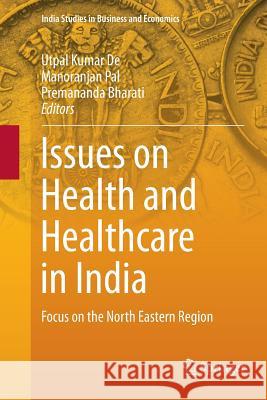Issues on Health and Healthcare in India: Focus on the North Eastern Region » książka



Issues on Health and Healthcare in India: Focus on the North Eastern Region
ISBN-13: 9789811355684 / Angielski / Miękka / 2019 / 465 str.
Issues on Health and Healthcare in India: Focus on the North Eastern Region
ISBN-13: 9789811355684 / Angielski / Miękka / 2019 / 465 str.
(netto: 384,26 VAT: 5%)
Najniższa cena z 30 dni: 385,52
ok. 22 dni roboczych.
Darmowa dostawa!
Two-Level Logistic Regression Analysis of Factors Influencing Anemia among Non-Pregnant Women of Reproductive Age in Bangladesh.- Prevalence and Associated Determinants of Low Birth Weight in Developing Countries: A Multi-Country Analysis from Nationwide Population-Based Survey.- Incidence of Teenage Pregnancy and Challenges on Child Health: A Cross-section Study in India.- Determinants of Psychological Wellbeing and its Impact on Mental Health.- Maternal Anemia: A Village Level Empirical Observation in Assam.- Measuring the Status and Identifying the Factors Influencing Child Immunization in Darjeeling District of West Bengal.- Gender Inequality and Child Nutritional Status.- Health in North-Eastern States of India: An Analysis of Economic Vulnerabilities.- Association of Economic Inequality with Health Inequality: Women in North-East India.- Prevalence of Malaria and HbE in North-East India: Genetics and Health Implications.- Child Deprivation in Indian Context: Concern about Heath and Education Related Issues.- The Role of Government Expenditure in the Healthcare System of Assam: An Overview.- Assessing burden of Infant Mortality on Socio-economic Classes in North-Eastern India.- A Predictive Approach to Study on Trends and Prospects of Fertility in India.- Prevalence of Child Undernutrition in India: Estimating Extent of Deficits Using Distributions of Nutritional Outcomes.- Health Expenditures across Major States of India: Issues of Convergence and Equality.- Health and Deprivation: A Suggested Application to the North-Eastern States of India.- Inequality in Child Mortality in the North-Eastern States of India.- The Determinants Out-of-Pocket Healthcare Expenditure in Bangladesh: Evidence from Household Income and Expenditure Survey-2010.- Access to Life Saving Medicines and Healthcare: A Case Study of Aurangabad District of Bihar.- Deprivation of Women in North-East India: An Exploratory Study.- Meteorological Conditions and Malaria cases, Study in Context to Meghalaya.- Comparative Study of Health Related Physical Fitness among Children Attending Municipality and International Schools in Nashik City.- Case Study of Porto Velho City Rondonia State Brazil on the Services Quality in Government Health Organization.- Factors Affecting Morbidity and Utilization of Health Care Services: A case study in Nagoan District of Assam.- Morbidity Pattern of Elderly in India.- Association of Nutritional Status and Drinking Water among the Children of North East India.
Utpal Kumar De is currently a Professor of Economics and Head of the Department of Economics at the North-Eastern Hill University, Shillong, India. Prof. De has been engaged in teaching at the postgraduate level since 1994. His research interests include agricultural economics and rural development, issues concerning environmental and natural resources, climate change adaptation, and empowerment of women. Prof. De has visited Europe and Asia in connection with research and delivered keynote and invited lectures at a number of conferences. Besides presenting over 60 research papers at various international and national conferences, he has published seven volumes, completed a number of research projects and published over 75 research articles in reputed national and international journals. He is listed in the Who’s Who in the World 2013 Pearl Anniversary Edition, inclusion in which is limited to those individuals who have demonstrated outstanding achievements in their own fields of endeavor and who have, thereby, contributed significantly to the betterment of contemporary society.
This book addresses health and healthcare issues in India with a special focus on the Northeast region. Pursuing a multidisciplinary approach, it highlights key issues in health and healthcare and outlines the actions needed to achieve the desired results in these areas as laid out in the UN Millennium Development Goals. In addition to introducing some new questions on health and healthcare development, it presents cross-country analyses, and examines the convergence of healthcare across Indian states, as well as mortality and morbidity in the Northeast.
The book also explores the regional complexities involved in the discussion of these topics. It presents a number of specific techniques, such as two-level logistic regression, analysis of mental health, probabilistic and predictive analysis of nutritional deficit, and generalized linear mixed models, that can be used to analyze mortality and morbidity and factors affecting out-of-pocket expenses in the healthcare context. Lastly, it presents concrete case studies substantiating the theoretical models discussed. As such, the book offers a valuable resource for health researchers, professionals and policymakers alike.
1997-2026 DolnySlask.com Agencja Internetowa
KrainaKsiazek.PL - Księgarnia Internetowa









